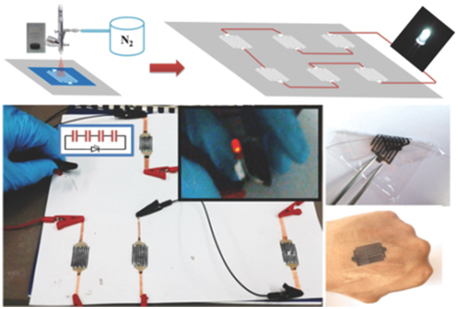Z. Liu, Z.-S. Wu, S. Yang, R. Dong, X. Feng*, K. Müllen*,
Advanced Materials 2016, 28: 2217-2222.
DOI:10.1002/adma.201505304 [PDF]

Abstract
In this work, we demonstrate novel and directly printable in-plane MSCs on paper and ultrathin polyethylene terephthalate (PET) substrates. Graphene ink with a concentration of 0.8 mg mL−1 was obtained by electrochemically exfoliating graphite under mild conditions. Such a graphene dispersion was stable in volatile 2-propanol (IPA) for at least 4 weeks. A hybrid ink composed of electrochemically exfoliated graphene (EG) and an electrochemically active poly(3,4-ethylenedioxythiophene):poly(styrenesulfonate) (PEDOT:PSS) formulation (Clevios PH1000) was subsequently prepared. By spray-coating the EG/PH1000 hybrid ink through a shadow mask with the designed MSC device geometry, the direct printing of MSCs was realized. The fabricated MSC on a paper substrate offered a significant areal capacitance as high as 5.4 mF cm−2, which is among the best reported performances of graphene-based MSCs, and exhibited an excellent rate capability with a capacitance retention of 75% when operated from 10 to 1000 mV s−1. We further demonstrated that light-emitting diodes (LEDs) could be readily illuminated by MSC arrays that were printed on a paper substrate. Moreover, using a PET (2.5 μm thick) substrate for the formation of the printed hybrid film resulted in an ultrathin MSC that exhibited “ultraflexiblity,” thus making it suitable for the next-generation flexible microelectrochemical energy storage devices. |